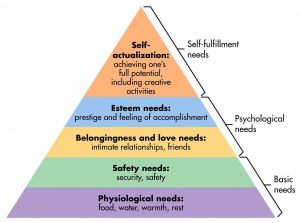Maslow's hierarchy
Everyone is driven to do stuff by a need, however, some needs come before others. Maslow, an American psychologist from the early 1900s, suggested that there is a defined hierarchy (see Figure 1), where the most important needs at the bottom have to be fulfilled before a person moves to the next, stage above. For instance, if you are hungry you buy some food, if you are cold you need to get warm. Once these basic needs (in purple - Figure 1) are met, then people can move up towards psychological needs such as building relationships and esteem.
Maslow's Hierarchy and Earth Population
In essence, Maslow's hierarchy of needs emphasizes that basic human requirements must be fulfilled before addressing broader issues. With approximately 9.2% of the global population, equivalent to 719 million people, living in extreme poverty without access to essentials such as food, clean water, sanitation, health, shelter, and education, it seems impractical to expect a unified response to humanity's wider common problem the ecological crisis.
So the earth is doomed? It seems that humanity is reluctant to give up its old ways and many have been looking for a technoutopian solution come to save us. However, Jevons Paradox and Greenwashing seem to be stopping this from being effective on a mass scale.
It seems our best bet, is to change what we can control. Do this locally and then propagate this collectively across the world we can make a difference. However, to start doing this we need to be able to change people's minds, unlearn bad habits and learn new ones. The most effective means at our disposal to do this is is to induce pivotal mental states to help people unlearn bad habits and then refocus on new transparent systems that will eliminate green washing and limit corruption and hopefully get us out of this mess.
References
